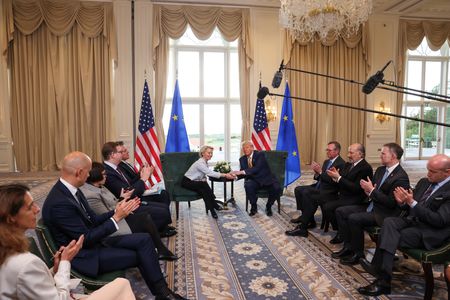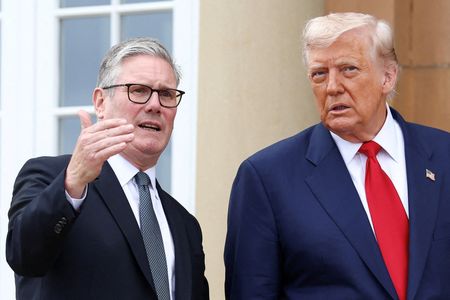By Alistair Smout
LONDON (Reuters) -The European Union and the United States announced a tariff deal on Sunday that will see most EU exports face a 15% tariff, nearly three months after Britain locked in a 10% baseline tariff rate.
EU leaders have said their deal offers more certainty given the threat of higher U.S. tariffs from August but some politicians have criticised it as “unbalanced” and worse than Britain’s deal.
The details of the two deals paint a more complicated picture than the headline figures suggest, and not all the small print of the EU deal has been confirmed.
Here is a comparison of what we know about the two deals.
BASELINE TARIFFS
The EU has agreed a 15% baseline tariff for most of its exports to the United States. While this is lower than a rate of up to 30% previously threatened by U.S. President Donald Trump, it is higher than the baseline tariff rate of 10% which applies to British exports.
However, under the EU deal, 15% is the maximum tariff, and isn’t added to any existing rate. For Britain, the 10% base rate is in addition to the “most-favoured nation” (MFN) rates that the U.S. applies as a minimum to specific goods imports from all its trade partners, so the effective tariff rate is often higher.
For instance, the UK Fashion and Textile Association has highlighted that certain luxury products face an MFN tariff of around 35% in the U.S., despite a “baseline” rate of only 10%.
PHARMACEUTICALS
The U.S. is to announce the result of its so-called Section 232 trade investigations into certain sectors in a few weeks and decide on tariff rates.
The EU-U.S. deal already determines a 15% tariff for European pharmaceuticals, and the results of the investigations will not change that, U.S. officials said.
In its deal with Britain, the United States said it would negotiate “significantly preferential treatment outcomes on pharmaceuticals”, contingent on the outcome of the 232 investigations.
Asked if Britain would be impacted by tariffs on the pharma sector in August, Trump said that he could deal with Britain on pharma and he didn’t think the sector would be a “block” in talks.
In the meantime Britain faces no tariffs for its pharmaceuticals. Britain also pledged to try to improve the overall environment for pharma firms operating in the country, but it is tussling with multinationals over drug pricing.
STEEL
Tariffs on EU steel and aluminium exports will stay at 50%, but von der Leyen said these would later be cut and replaced by a quota system.
British steel and aluminium exports face a 25% tariff in the United States, which both sides have agreed will go down to zero once talks over quotas and supply chains are concluded.
Those talks have stalled over “melted and poured” rules about where the steel originates and how it is processed.
Britain’s Tata Steel has imported steel from India and the Netherlands after shutting blast furnaces last year, so Britain is seeking an exemption from a U.S. demand that steel needs to be “melted and poured” in Britain to qualify for lower tariffs.
AUTOS
Car exports from the EU to the U.S. face the baseline tariff of 15% in the deal struck on Sunday. While full details have not been published, neither side mentioned a quota for the number of cars covered by the rate.
Britain has negotiated a lower tariff of 10% for its car sector but it also has a 100,000-vehicle quota which leaves little room for export growth. Above that quota, British car exports face a tariff of 25%.
AEROSPACE
The EU will face no U.S. tariffs on aerospace exports, pending the outcome of a Section 232 probe into the sector.
Britain also has no tariffs on its aerospace sector after its deal with Washington reduced them from 10%.
(Reporting by Alistair Smout in London, additional reporting by Jan Strupczewski and Philip Blenkinsop in Brussels; editing by Giles Elgood)











